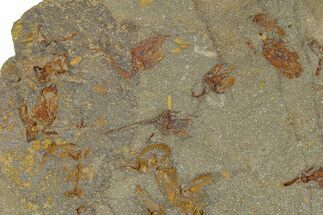This Specimen has been sold.
.4" Edrioasteroid On Brachiopod Shell- Ontario
This is a .4" Edrioasteroid attached to a 1" unidentified brachiopod shell from the Veralum Formation, Ontario, Canada. It is still in the rock in which it was fossilized.
Edrioasteroids are an extinct class of echinoderms. Distantly related to starfish and sea urchins, they have a body laid out in a pentaradial (five-fold symmetry) pattern. They also had a water vascular system and a skeleton made of calcite plates. They were filter feeders who lived permanently attached to an object or the seafloor. Some are thought to have had short stems like crinoids, but most lived flat on whatever object they had attached to as larvae. Edrioasteroids appear in the Cambrian Period about 515 million years ago. Their diversity peaked during the Late Ordovician Period. By about 275 million years ago, during the Permian Period, edrioasteroids are extinct.
Edrioasteroids were small organisms from a few millimeters to a couple centimeters wide. They look like a tiny cushion attached to a substrate. The mouth was in the center of the theca (body) and from it, five ridges radiate out in a pentaradial pattern. These ambulacra channel food along the body to the mouth. There is little fossil evidence of how this was done, but by looking at modern echinoderms, it is likely Edrioasteroids had cilia or tube feet along the ambulacra that moved the food to the mouth. The ambulacra radiate out from the mouth in either straight lines, or curving to form a whorl. Usually they all curve in the same direction, but in a few species they curve in different directions.
Edrioasteroids were small organisms from a few millimeters to a couple centimeters wide. They look like a tiny cushion attached to a substrate. The mouth was in the center of the theca (body) and from it, five ridges radiate out in a pentaradial pattern. These ambulacra channel food along the body to the mouth. There is little fossil evidence of how this was done, but by looking at modern echinoderms, it is likely Edrioasteroids had cilia or tube feet along the ambulacra that moved the food to the mouth. The ambulacra radiate out from the mouth in either straight lines, or curving to form a whorl. Usually they all curve in the same direction, but in a few species they curve in different directions.
Brachiopods are members of the phylum Brachiopoda. They are clam-like with wide shells composed of two halves called valves. They are filter feeders that live fixed to rocks or on the seafloor. Brachiopods first appeared in the early Cambrian as simple forms with non-articulating shells. Their diversity peaked during the Devonian, and there are currently 12,000 described fossil species of Brachiopoda from 5,000 genera. Most species of brachiopod died out during the Permian-Triassic Extinction but about 450 species still live today. They live in cold marine environments like polar seas or continental shelves and slopes. The largest fossil Brachiopod found is 7.9 inches (200 mm), but most are 2-4 inches (3-8 cm). Living Brachiopods also fall into this range.
Brachiopods are more closely related to Bryozoans than Mollusks. The easiest differences to identify are in the shells of clams, part of the mollusk family, and Brachiopods. Mollusk shells are divided into left and right while brachiopod shells are divided top (dorsal) and bottom (ventral). Mollusk shells are usually equal on the right and left. In brachiopods, the bottom shell is larger than the top. The other big difference is in how they feed: both are filter feeders, but mollusks extend their filter into the water and pull food into their shells. Brachiopods have internal feeding structures: water is drawn into the shell where the food is filtered out before expelling it out.
Brachiopods are more closely related to Bryozoans than Mollusks. The easiest differences to identify are in the shells of clams, part of the mollusk family, and Brachiopods. Mollusk shells are divided into left and right while brachiopod shells are divided top (dorsal) and bottom (ventral). Mollusk shells are usually equal on the right and left. In brachiopods, the bottom shell is larger than the top. The other big difference is in how they feed: both are filter feeders, but mollusks extend their filter into the water and pull food into their shells. Brachiopods have internal feeding structures: water is drawn into the shell where the food is filtered out before expelling it out.
SPECIES
Isorophusella incondita, Uidentified Brachiopod
LOCATION
Gamebridge, Ontario
FORMATION
Verulam Formation
SIZE
.4" larger, 1" brachiopod shell
CATEGORY
SUB CATEGORY
ITEM
#110538
We guarantee the authenticity of all of our specimens.
 Reviews
Reviews












